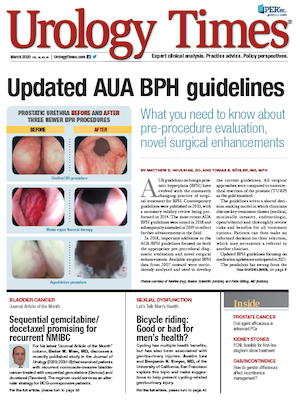Publication
Article
Urology Times Journal
Pain interference more pronounced following URS
Author(s):
Findings from a longitudinal cohort study provide an evidence base for counseling patients about pain and recovery following ureteroscopy for nephrolithiasis.
Findings from a longitudinal cohort study provide an evidence base for counseling patients about pain and recovery following ureteroscopy for nephrolithiasis.
The findings also support the practice of not prescribing narcotics for pain management, reported Justin B. Ziemba, MD, at the 2019 World Congress of Endourology and SWL in Abu Dhabi.
“We know that pain is the most common complaint after ureteroscopy for nephrolithiasis, but we have been lacking good data for counseling patients about this aspect of their recovery,” said Dr. Ziemba, assistant professor of urology in surgery at the Perelman School of Medicine at the University of Pennsylvania, Philadelphia.
The study was initiated in November 2018 and analyzed data collected for nearly 1 year. English-speaking adults undergoing ureteroscopy for a renal or ureteral stone were eligible for participation. Patients were discharged with a ureteral stent that was removed by post-op day 4. Patients received a non-narcotic regimen for pain control that included ibuprofen, acetaminophen, and tamsulosin (Flomax).
They were asked to complete two generic quality of life instruments, PROMIS-Pain Intensity and PROMIS-Pain Interference, immediately before surgery and on post-op days 1, 7, and 14. Scores are reported compared to the U.S. population mean; a score above 50 indicates that the condition is worse than in the average population.
Also see - Robotic ureteroscopy: The future of stone management?
“These quality of life instruments can be applied to any disease state, have been rigorously studied and validated in diverse populations, and are benchmarked against a normalized score for the United States general population. Therefore, we hypothesized that these instruments would provide us with reliable information about the severity of postoperative pain and how the pain disrupted participation and engagement in regular activities. It also provides us with a measure of how this compares to a normal population mean,” Dr. Ziemba said.
“In contrast to other studies that have assessed emergency department visits or calls to the office to investigate the impact of postoperative recovery following ureteroscopy, our study evaluates the lived patient experience with respect to pain intensity and interference,” Dr. Ziemba said.
The questionnaires were completed by 101 patients immediately before surgery and by 62, 48, and 21 patients on post-op days 1, 7, and 14, respectively.
Results from the data collected showed that, compared to the U.S. population mean (50), intensity and interference were all clinically and statistically significantly different (Wilcoxon signed rank test; p<.001) at all time point comparisons except intensity on post-op days 1 and 7 and interference on post-op day 14.
The study also found that for pain intensity, there was a clinically and statistically significant difference from post-op day 0 to 1 (43.8 to 52.1) and from post-op day 7 to 14 (49.1 to 40.5) (Friedman’s 2-way ANOVA; p<.01). Similarly, for pain interference, there was a clinically and statistically significant difference from post-op day 0 to 7 (56.0 to 62.8) and post-op day 7 to 14 (62.8 to 48.5) (Friedman’s 2-way ANOVA; p<.01).
Next: Several factors linked with intensity scoreSeveral factors linked with intensity score
On the first day after surgery, age, gender, first stone, presence of a stent preoperatively, and intraoperative time were significantly associated with intensity score, but only having a preoperative stent and longer intraoperative time were associated with the interference score. By post-op day 7, no significant associations were found between any of the demographic or clinical characteristics and either pain intensity or interference.
Read: Protocol cuts opioid prescribing in stone patients
“According to our study, we can now be more confident telling patients that pain intensity is not the driving force of discomfort after surgery, but it is the interference of usual daily activities from the pain that is most pronounced,” said Dr. Ziemba.
“However, the vast majority of people recover quickly, with virtually all reporting pain intensity and interference at or below levels reported by an average American by 14 days after surgery. In addition, the data show that our opioid-free postoperative pain protocol is effective, as pain intensity never increases beyond the level reported by an average American.

Newsletter
Stay current with the latest urology news and practice-changing insights — sign up now for the essential updates every urologist needs.



























